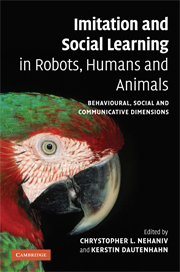 Imitation and Social Learning in Robots, Humans and Animals
Imitation and Social Learning in Robots, Humans and Animals Book contents
- Frontmatter
- Contents
- List of plates
- List of figures
- List of tables
- List of contributors
- Introduction: the constructive interdisciplinary viewpoint for understanding mechanisms and models of imitation and social learning
- Part I Correspondence problems and mechanisms
- 1 Imitation: thoughts about theories
- 2 Nine billion correspondence problems
- 3 Challenges and issues faced in building a framework for conducting research in learning from observation
- Part II Mirroring and ‘mind-reading’
- Part III What to imitate?
- Part IV Development and embodiment
- Part V Synchrony and turn-taking as communicative mechanisms
- Part VI Why imitate? – Motivations
- Part VII Social feedback
- Part VIII The ecological context
- Index
- Plate section
- References
1 - Imitation: thoughts about theories
Published online by Cambridge University Press: 10 December 2009
- Frontmatter
- Contents
- List of plates
- List of figures
- List of tables
- List of contributors
- Introduction: the constructive interdisciplinary viewpoint for understanding mechanisms and models of imitation and social learning
- Part I Correspondence problems and mechanisms
- 1 Imitation: thoughts about theories
- 2 Nine billion correspondence problems
- 3 Challenges and issues faced in building a framework for conducting research in learning from observation
- Part II Mirroring and ‘mind-reading’
- Part III What to imitate?
- Part IV Development and embodiment
- Part V Synchrony and turn-taking as communicative mechanisms
- Part VI Why imitate? – Motivations
- Part VII Social feedback
- Part VIII The ecological context
- Index
- Plate section
- References
Summary
Many behavioural features and psychological states can be transmitted between natural systems. A person or animal can acquire through observation of another a tendency to go to the same place, effect the same transformation of an object, perform the same body movements, make the same sounds, feel similar emotions or think similar thoughts. In our discussion of imitation we will focus on cases in which body movements are transmitted or ‘copied’ between model and observer, because these cases present a distinctive explanatory challenge.
The problem of producing a movement that matches one observed is made difficult due to the nature of the codes representing the observed and executed movements. The observer must formulate motor commands to match visual input. This is a special case of what has become known as the ‘correspondence problem’ (Alissandrakis et al., 2002; Nehaniv and Dautenhahn, 2001), and it is made particularly difficult when simple perceptual matching cannot be used to produce imitative movements, as in the following example. A tennis coach demonstrates a serve to a novice, which the novice then attempts to imitate. If the novice successfully imitates the coach's action the two actions will not ‘match’ from the novice's perspective. The novice will perceive the coach's actions as a whole body movement, in which the back arches and one arm moves in an overhead arc.
- Type
- Chapter
- Information
- Imitation and Social Learning in Robots, Humans and AnimalsBehavioural, Social and Communicative Dimensions, pp. 23 - 34Publisher: Cambridge University PressPrint publication year: 2007
